Dec . 11, 2024 04:01 Back to list
Understanding Midstream Ovulation Tests for Accurate Fertility Tracking
Understanding Midstream Ovulation Tests A Comprehensive Guide
Ovulation is a key process in the female reproductive cycle, playing a vital role in conception. Many women who are trying to conceive or monitor their reproductive health find ovulation tests invaluable. Among various types of ovulation tests, midstream ovulation tests have gained popularity due to their ease of use and convenience. This article will delve into the features, benefits, and usage of midstream ovulation tests.
What are Midstream Ovulation Tests?
Midstream ovulation tests are urine-based kits designed to detect the surge of Luteinizing Hormone (LH) in a woman's body. LH is a hormone that triggers ovulation, making its detection essential for understanding fertile windows. Unlike traditional ovulation tests that require collecting urine in a cup, midstream tests can be held directly in the urine stream, making them user-friendly and quick to use.
How Do Midstream Ovulation Tests Work?
Understanding how midstream ovulation tests function is crucial. The test strip within the device is sensitive to LH levels in the urine. As ovulation approaches, LH levels spike, typically 24 to 48 hours before the ovary releases an egg. Users simply hold the test in their urine stream for a specified duration, usually a few seconds, and wait for the results.
The test usually displays two lines one control line and one test line. If the test line is as dark or darker than the control line, it indicates an LH surge, suggesting that ovulation is imminent. In contrast, a lighter test line means that there is no imminent ovulation detected.
Benefits of Using Midstream Ovulation Tests
1. Ease of Use The midstream design allows for straightforward testing without any need for additional utensils. This is particularly beneficial for women who are busy or on the go.
2. Quick Results Most midstream ovulation tests provide results within minutes, allowing users to track their ovulation cycle effectively without lengthy waiting times.
ovulation test midstream

4. Discretion The compact design makes it easy to carry in a purse or bag, enabling women to test discreetly wherever they are.
5. Clear Instructions Most brands provide easy-to-follow instructions, making them accessible even to those who are unfamiliar with ovulation monitoring.
Tips for Effective Use
To maximize the effectiveness of midstream ovulation tests, consider the following tips
- Know Your Cycle Understanding your menstrual cycle is essential. Ideally, start testing a few days before you expect to ovulate, which is typically about 14 days before your next period.
- Timing It’s optimal to test at the same time each day. Avoid using morning urine as it may have concentrated LH levels; testing in the afternoon or early evening is often recommended.
- Stay Hydrated, But Not Too Much While hydration is important, excessive fluid intake before testing can dilute urine, potentially leading to inaccurate results.
- Track Patterns Keep a record of your test results over several months to identify trends in your ovulation cycle, which can aid in pinning down your expected ovulation days.
Final Thoughts
Midstream ovulation tests are a practical and efficient tool for women looking to understand their ovulation patterns and improve their chances of conception. By following the instructions and understanding how to interpret the results, women can gain valuable insights into their fertility. Whether for family planning or tracking reproductive health, midstream ovulation tests offer a user-friendly option tailored to modern lifestyles. As always, consult with healthcare providers if you have specific concerns about fertility or reproductive health.
-
Accurate Cocaine (Coc) Rapid Test Kit | Fast & Reliable Detection
NewsJul.31,2025
-
Accurate HCG Pregnancy Test Strips | Fast Home Use Kit
NewsJul.31,2025
-
Reliable Early Pregnancy Test Kit Supplier - Multi Plastic Cassette Options
NewsJul.30,2025
-
Transferrin Rapid Test Cassette – Reliable Tumor Marker Detection
NewsJul.29,2025
-
Accurate Follicle Stimulating Hormone Test Kit | Rapid Reliable Results
NewsJul.29,2025
-
High Accuracy LH Ovulation Test Kit - Digital Results & Wholesale Options
NewsJul.29,2025

